We want children to be able to read any book of their choosing, and write authentically – to share knowledge, to express themselves creatively, to put their unique voices on paper. But we must build the foundational skills of reading and writing first! Sentence dictation plays an essential role in that.

Here are four benefits of dictation that Wiley Blevins points out in his book, A Fresh Look at Phonics:
- It accelerates students’ APPLICATION of taught phonics skills. It is through the act of writing that phonics knowledge is tested and consolidated!
- It provides much-needed practice in the sound-spelling patterns we’ve taught our students, as well as irregular high-frequency words previously introduced, in a meaningful way.
- It is a systematic way for us to show our students how to use their developing skills, no matter where they are on the spelling continuum, and give them corrective, supportive feedback.
- It provides us with useful information about our students’ spelling and writing skills, thus helping us target future instruction.
How Should We Teach Sentence Dictation?
Blevins recommends doing sentence dictation at least twice per week, beginning as early as Kindergarten. I try to do it every day or every other day, depending on the group of kids and how much time we have together.
For a step-by-step process, I like the sentence dictation routine outlined in Judith Birsh’s Multisensory Teaching of Basic Language Skills (commonly referred to as “the sunflower book”).
The chapter on “Teaching Spelling” written by Suzanne Carreker explains the four steps for effective sentence dictation.
1. Look and Listen
Ask students to listen to you say a sentence. I’ve found that it’s helpful to use exaggerated expression doing this. Direct your students to pay close attention to your mouth while you’re speaking.

2. Echo
Ask students to repeat the sentence you just said. I call out the command, “Fists in the air.” Students raise a fist and get ready to count the words as I say the sentence again. Then I ask them to repeat the sentence back to me, counting on their fingers to make sure they got all of the words. Then they write that number of lines on their paper or dry erase board. This may take a few tries if your students have memory difficulties.

3. Write
When students have recited the sentence back to you correctly, tell them to write. To build the habit of not writing until they can remember what the sentence was, I ask my students to hold their pencil/marker up in their other hand or place it at the top of their paper/dry erase board. Then after they demonstrate that they remember the sentence, I say “Write!” and they drop their hand down or pick up their writing instrument. Carreker suggests a nonverbal cue so as not to interrupt students’ auditory memory of the sentence sequence. I honestly never thought about this before, but it’s something I’d like to try.

4. Proofread
This one is so important! After students THINK they’re done, you read the sentence THREE MORE TIMES. Students will check for something different each time. The first time you reread it, they should point to each word on their paper and check for missing words. When they’ve added the missing word(s) or confirmed they got them all, they put a check at the end of the sentence. For the second time you reread the sentence, students should check for correct capitalization and punctuation. They put a second check at the end of the sentence after confirming or adding correct capital letters and punctuation. For the third and final reread, students should check for spelling errors and place a third check mark if they think everything looks good.
In addition to this, I make students chorally (or individually depending on group size) read their sentence back to me. Then I ask them to “help me” write the sentence on the board. I draw lines for the numbers of words. Then I ask them how to spell each word (which gives younger students practice with letter naming). Sometimes with older students I purposely make mistakes and ask them to help me fix them. I ask, “Is this how you spell ________?” They love saying “NO, you’re wrong!” This helps reinforce the message that mistakes are okay and help us learn. It keeps the lesson light and the kids feeling good. If students still have any errors after all of that, I place a line under the appropriate place on their paper and have them write the word correctly, but usually they’ve already made all the necessary corrections.

What Do We Need to Implement Effective Sentence Dictation Routines?
One of the great things about sentence dictation is the minimal prep involved. You really just need pencils and paper or whiteboards and dry-erase markers. Other than that, you just need the sentences! Most explicit phonics programs give you at least a handful of sentences to use for dictation, targeting each skill in their particular scope and sequence.

I’ve felt a little unsatisfied with the sentences provided by the programs I’ve used (and I’ve used a lot over the past 20 years) for various reasons. Either there weren’t enough sentences, the sentences were awkward and/or meaningless, or there were no visuals of any kind to both anchor the sentences in students’ memory and give an extra boost of interest and meaning. There also have never been options for differentiation based on the varying needs of support that students may require.
If you’ve felt similar frustrations with the sentence dictation portion of your phonics program and are in need of resources to enhance it, OR if you don’t have your hands on an explicit program, you may be interested in my dictation sentence packages.
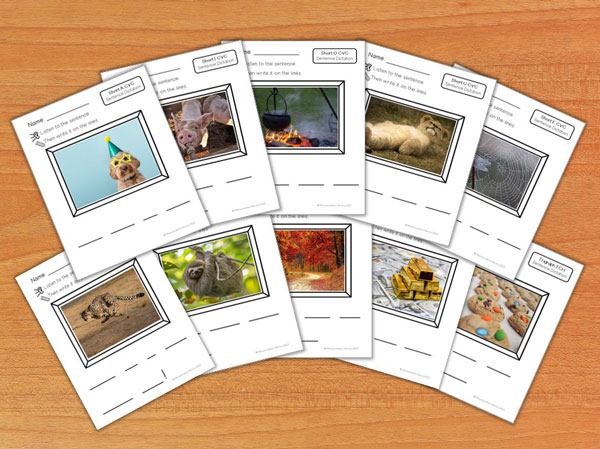
Currently, I have developed sentence dictation resources for 18 different phonics skills, including short vowels, digraphs, trigraph TCH, suffix -S, initial blends, final blends, and VCE words. The details of these resources are provided below.
- Ten dictation sentences for the targeted phonics skill
- Engaging real photographs for each dictation sentence
- Differentiated pages for varying levels of support (dictation lines, handwriting lines, sentence completion, more open-ended writing pages (caption or paragraph) with the same picture prompt as the dictation pages
- Bonus Google Slides™ for the teacher to project the image on a screen and reveal the sentence one word at a time when students are ready to check/correct their work
As you progress through your scope and sequence, you can pick and choose the resources for the skills you need to teach.
If you would rather save time and money, you can get all 18 skills at once with my sentence dictation bundle! Click the image below to check it out.
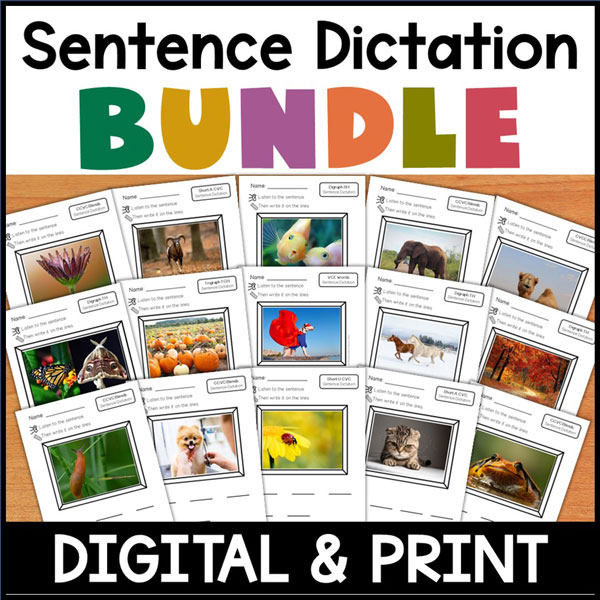
An Example of an Effective Sentence Dictation Lesson
I’d like to show you how you can implement one of my sentence dictation resources into your lessons, if you so choose! We will be following the four-step framework I outlined at the beginning of this article.
For my example, I will be using one of the sentences from the short U CVC dictation resource. By the way, you can get the entire short U resource for free.
1. Have Students Look and Listen to You As You Read the Sentence
Ask your students to listen to you as you give them a sentence to write. Prompt them to watch your mouth closely as you speak each word.
Then state the sentence, “The cub had fun.” Use an exaggerated expression, especially as you emphasize the short vowel CVC words.
To build interest and engagement, you can display an image along with your sentence. You can do this with a printed page for each student.
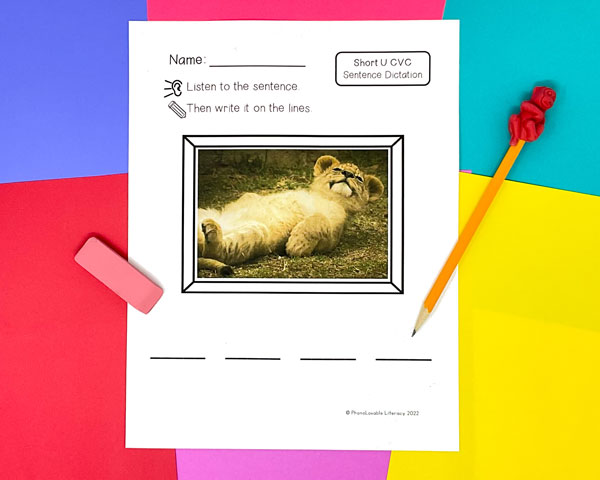
Another way to go about it is to display a digital image onto a screen in your classroom. You can plan to have your students write the sentence on dry erase boards. This is a great paper-saving option.

A third option is to combine the two methods. Project the image while the students use the printed page for writing their sentence.
2. Have Students Echo the Sentence Back to You
Call out, “Fists in the air.” Tell your students to get ready to count the words in the sentence as they repeat it. Then say the sentence again: “The cub had fun.”
Your students should repeat the sentence: “The cub had fun.” As they do so, they should hold up one finger for each word.
The next step is for your students to write that number of lines on their paper or dry erase board.
My sentence dictation resources have many differentiation options. There are four versions for students needing different levels of support. As you can see here, there is a version for:
- Writing each word on one line
- Writing each word on a separate handwriting line
- Writing the entire sentence on longer handwriting lines
- Writing only one word to complete the sentence
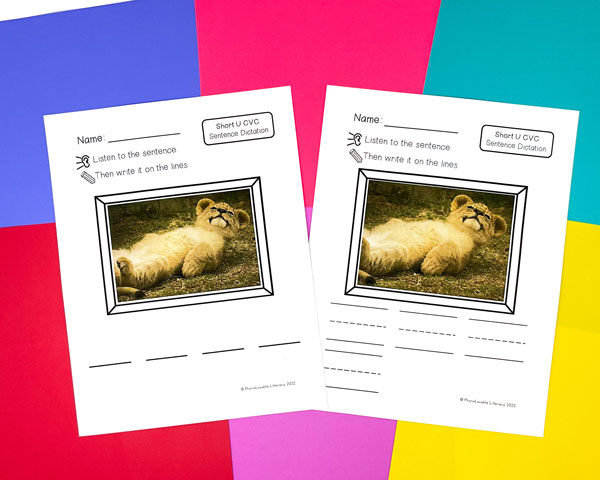
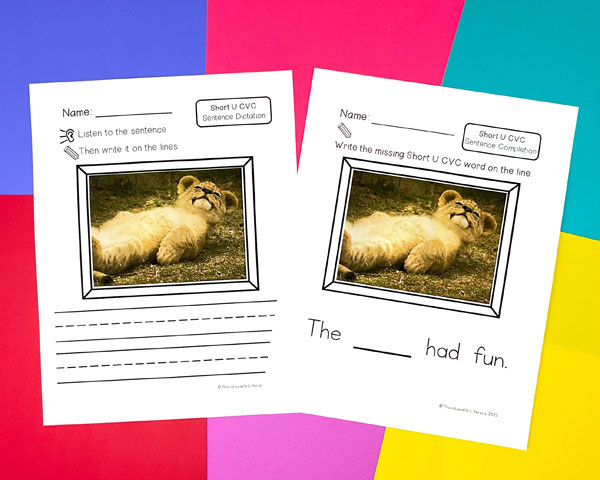
If using one of these printed sentence dictation pages, your students will either point to the lines, draw the lines, or point to the words, depending on which page they are using.
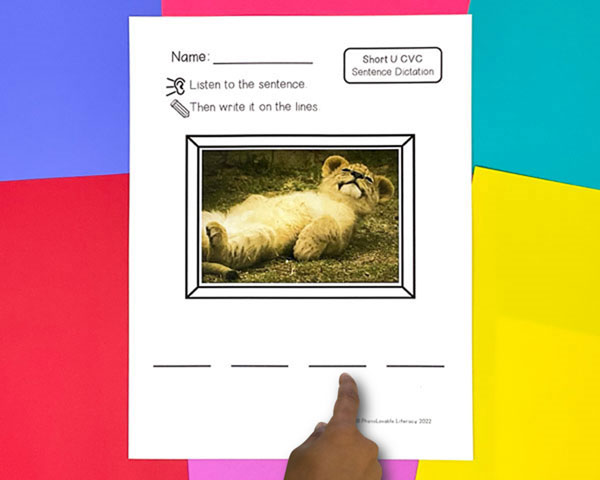
If using dry erase boards, they will draw the necessary number of lines on their boards.
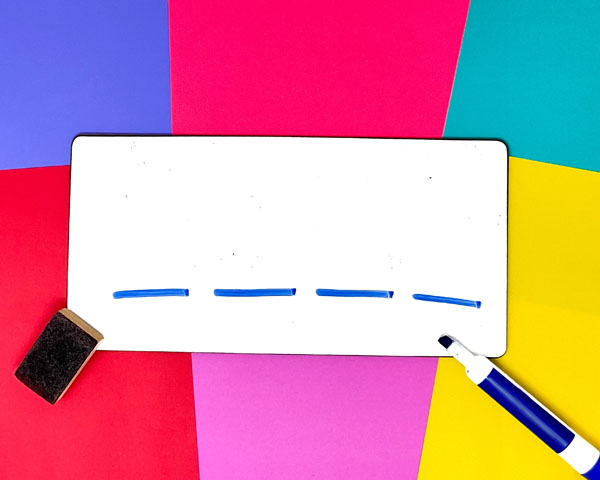
There are also two advanced versions for students who are beyond the needs of sentence dictation (more on that later).
3. Have Students Write the Dictated Sentence
At this point, you are confident that your students know the sentence they need to write. They have proven this by repeating the sentence and verifying each word in the sentence. Now you have to direct them to write it!
You can do this either by saying “Write!” or by using a nonverbal cue that you have previously taught them.
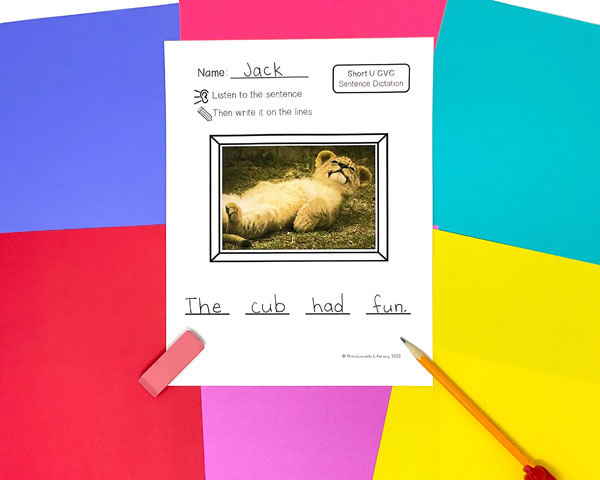
4. Proofread the Dictated Sentence Together
So we’re getting close, but we’re not done yet! Remember the “3 Checks” rule from earlier. You need to read the sentence three more times!
Tell students that, as you read the sentence for the first check, they need to point to each word on their paper (or board) and check to see if anything is missing. Once they think they have all four words, they can add a check mark after their sentence.
Tell students that, as you read the sentence again for the second check, they will make sure they have proper capitalization and any punctuation they should know. Then they can add a second check mark.
Tell your students to check for the correct spelling of each word as you read the sentence one last time for their third check mark.
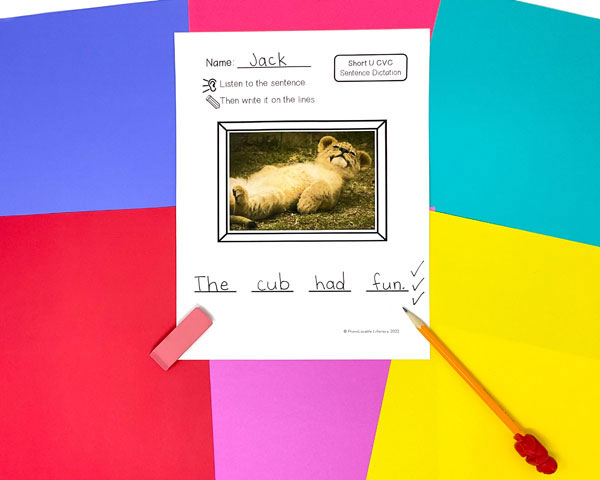
Tell students to read the sentence back to you. Then ask them to help you write the sentence. If you are using your board, you can draw four lines just like your students did. Then call on students to spell each word.
If using the digital slides that come with the sentence dictation resources, you have the option of revealing each word one at a time.

Differentiation Options for Your Advanced Students
This lesson example is great for those students just learning to write their CVC words and apply them to basic sentences. But what about your students who can easily write much longer sentences without giving it a second thought?
Obviously, your advanced students need a more challenging task than this sentence dictation lesson can provide.
That’s why I’ve included two advanced variations to each of the prompts in all of my sentence dictation resources.
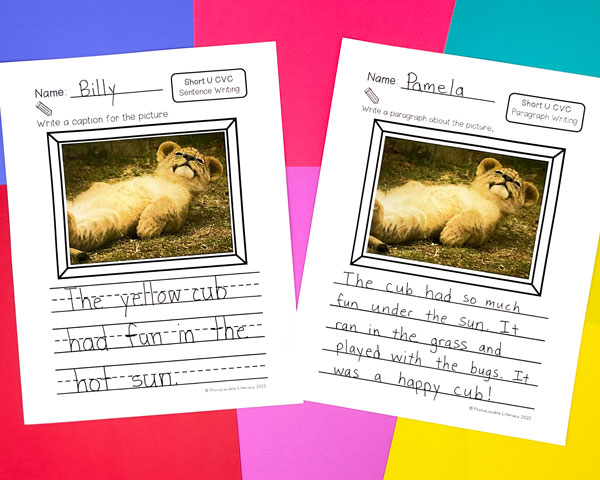
One variation allows students to make up their own caption sentence to match the picture. The other variation is for those students capable of writing multiple sentences. Let them write a descriptive paragraph, or encourage their creativity as they make up their own story!
Free Sentence Dictation Sample Pack
If you’d like to try out a sample printable pack of 10 sentences for dictation (including CVC and short vowel words with consonant digraphs CK, TH, SH, CH and trigraph TCH) along with pages for differentiation and digital slides for a paper-free version, you will receive them for free as a thank-you gift for signing up for my newsletter, which is also free.

By signing up with this link, you will receive the free set of sentence dictation activities. You’ll also start receiving my occasional emails of structured literacy teaching tips. I promise not to bombard you with emails! You may also unsubscribe at any time.
Final Thoughts on Sentence Dictation
If sentence dictation is already included in your lessons, I hope I was able to provide a good refresher or a new tip or two. If you haven’t begun incorporating dictation yet, I hope to have highlighted its importance and helped you feel confident and excited to get started!

